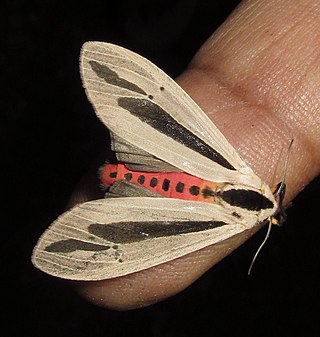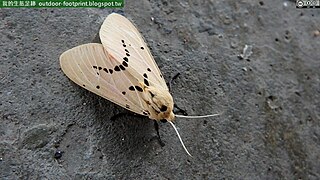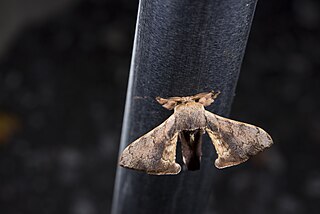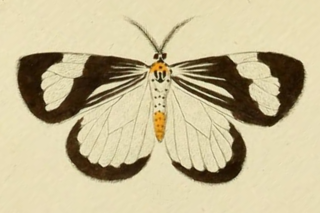
Creatonotos is a genus of tiger moths in the family Erebidae. The moths in the genus are found in the Afrotropics, South and East Asia, Sundaland and Australia.

Spilarctia is a genus of moths in the family Erebidae. The genus was erected by Arthur Gardiner Butler in 1875.
Cretonia is a genus of moths of the family Noctuidae. The genus was erected by Francis Walker in 1866.

Psimada is a monotypic moth genus of the family Noctuidae. Its only species, Psimada quadripennis, is found in the Indian subregion, southern China, Taiwan, Myanmar, Thailand, Sri Lanka, the Andaman Islands, Sundaland, Sulawesi and Seram. Both the genus and species were first described by Francis Walker in 1858.

Targalla is a genus of moths of the family Euteliidae. The genus was erected by Francis Walker in 1858.
Pyrrolizidine alkaloid sequestration by insects is a strategy to facilitate defense and mating. Various species of insects have been known to use molecular compounds from plants for their own defense and even as their pheromones or precursors to their pheromones. A few Lepidoptera have been found to sequester chemicals from plants which they retain throughout their life and some members of Erebidae are examples of this phenomenon. Starting in the mid-twentieth century researchers investigated various members of Arctiidae, and how these insects sequester pyrrolizidine alkaloids (PAs) during their life stages, and use these chemicals as adults for pheromones or pheromone precursors. PAs are also used by members of the Arctiidae for defense against predators throughout the life of the insect.

Argina astrea, the crotalaria podborer, is a moth of the family Erebidae. The species was first described by Dru Drury in 1773. It is found in eastern Africa, southern Asia of India, Sri Lanka, Maldives and Indo-Australia, including the Pacific Islands and Australia.
Meganola brunellus is a moth of the family Nolidae. It is found in Sri Lanka, India, Taiwan, Japan, the Ryukyu Islands, Sundaland, Queensland and the Bismarck Islands. It is an introduced species in Hawaii.

Creatonotos gangis, the Baphomet moth or Australian horror moth, is a species of arctiine moth in South East Asia and Australia. It was described by Carl Linnaeus in his 1763 Centuria Insectorum.

Mesoptila melanolopha is a moth in the family Geometridae first described by Charles Swinhoe in 1895. It is found in Nepal, China, Korea, Japan, Taiwan, India, Sri Lanka, Thailand, Vietnam, Malaysia and on Java, Bali and Borneo.

Trilocha varians, the Greenish silk-moth is a moth in the family Bombycidae described by Francis Walker in 1855. It is widespread in the Oriental region from India, Sri Lanka, China, extending to Taiwan, the Philippines, Pakistan, Sulawesi and Java.

Scirpophaga incertulas, the yellow stem borer or rice yellow stem borer, is a species of moth of the family Crambidae. It was described by Francis Walker in 1863. It is found in Afghanistan, Nepal, north-eastern India, Sri Lanka, Bangladesh, Myanmar, Vietnam, Thailand, Malaysia, Singapore, Sumatra, Java, Borneo, Sumba, Sulawesi, the Philippines, Taiwan, China and Japan.
Creatonotos kishidai is a moth of the family Erebidae. It was described by Vladimir Viktorovitch Dubatolov and Jeremy Daniel Holloway in 2007. It is found on Sulawesi.

Hemonia rotundata is a species of moth in the family Erebidae. It was described by Snellen in 1879. It is found on Java, Bali, Borneo, Peninsular Malaysia, the Philippines and Sulawesi. The habitat consists of primary and secondary forests.
Lemyra maculifascia is a moth of the family Erebidae. It was described by Francis Walker in 1855. It is found in China, Indonesia, Timor, the Philippines, New Guinea and Australia. It is found in secondary habitats, including bush, clearings in primary forests and plantations, from the sea level up to elevations of about 1,200 meters.

Nyctemera tripunctaria is a moth of the family Erebidae first described by Carl Linnaeus in his 1758 10th edition of Systema Naturae. It is found in southern China, Cambodia, Thailand, Vietnam, Sundaland, the Philippines and on Sulawesi.
Spilarctia strigatula is a moth in the family Erebidae. It was described by Francis Walker in 1855. It is found in Sundaland, Thailand, Nepal and Myanmar.

Hydroxydanaidal is an insect pheromone synthesized by some species of moth from pyrrolizidine alkaloids found in their diet.

Thalassodes immissaria is a moth of the family Geometridae first described by Francis Walker in 1861. It is found in the Oriental tropics of China, India, Myanmar, Sri Lanka, Hong Kong, Japan, Borneo, Vietnam, Sumatra, Sulawesi and the Ryukyu Islands. The populations in Ryukyu were often classified as a subspecies - Thalassodes immissaria intaminataInoue, 1971. However, in 2005 this subspecies was upgraded to a distinct species, which can be distinguished from immissaria by careful examination of the male genitalia.












